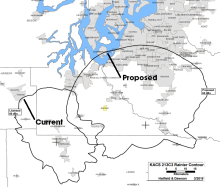In March 2016 non-commercial educational FM station KACS, Chehalis, Washington -- licensee Chehalis Valley Educational Foundation ("CVEF") -- filed an application for minor change of facilities, proposing to move its community of license from Chehalis, WA to Rainier, WA. The move would essentially move the station from serving the Chehalis area to rimshotting into Puget sound vicinity at an elevation of 577 meters at 2.1 kW. The argument in support of this application is that this would be the first local service for the town of Rainier. Whether this FCC bought this argument or not was precluded by the fact that the proposal did not pass precedent procedure for demonstration of preferential arrangement of allotments and 47 CFR § 73.3573.

Although its been done numerous times, the FCC frowns upon licensees abandoning rural coverage to add additional stations to urbanized regions that are already amply served. Since 1982, the allotment priorities are: (1) First fulitime aural service, (2) Second fulltime aural service, (3) First local service and (4) Other public interest matters (co-equal weight is given to Priorities (2) and (3)).
Although Rainier was stipulated as first local service -- i.e., no other station has chosen the community in namesake -- the application lists the more stations serve Rainier than Chehalis. But the FCC real assertion was that the proposed service contour of 60 dBu covered 53.6 percent of Olympia-Lacey, Washington urbanized area, and existing license site of KACS does not cover any part of the urbanized area. Within a letter judgement September 8, 2017, citing the Rural Radio proceeding from 2011, the FCC concluded that if a station -- through a minor modification application -- covered more than 50% of a (newly proposed) urban area, the FCC "will treat the application as a proposal to serve the entire urbanized area, rather than as a proposal for local service to the named community of license." Because that urban area already has numerous FM and AM services, this proposal would not satisfy "Priority (3)" of the Commission allotment priorities.
The judgment was appealed via Petition for Reconsideration by CVEF. CVEF stated the FCC erred in its decision because it was customary to use 70 dBu contours (not the greater-covering 60 dBu contour) to denote the principal community contour referred to in Rural Radio, for which CVEF's newly proposed contour would not extend past the 50% threshold. CVEF states:
Completely aside from rules and precedent, there would be no rationale for making it more difficult for noncommercial stations to pursue proposals to change the community of license than for commercial stations – most assuredly not in reliance on a 60 dBu contour trigger for the UAP
In a Denial letter, the FCC refutes CVEF's argument. FCC essentially states that 70 dBu service contours are only used for commercial stations, and 60 dBu is the official strength for service contours for non-commercial educational stations:
...unlike commercial stations that use the 70 dBu contour as the principal community contour, the Commission has chosen to measure an NCE FM station's service to its community of license on the basis of 60 dBu signal strength.....Use of the 60 dBu principal community contour affords greater flexibility in most instances to NCE FM stations seeking a community of license change, pursuant Section 73.3573(g) of the Rules, as it provides for a larger contour and thus the ability for an NCE FM station to move its community of license a larger
distance and still have the required mutual exclusivity.
CVEF then files for Commission Review of the matter, doubling down on the issue that the 70 dBu must be used, and not the 60 dBu contour:
The Bureau would apparently have no objection to this application if KACS were a commercial station. Everyone agrees that the UAP would not be triggered in that event because the 70 dBu contour does not cover any significant portion of an urbanized area. Thus, the inappropriate imposition of the 60 dBu contour as the UAP trigger has the perverse effect of
substantially restricting a move by a noncommercial station that a commercial station could easily effectuate with the blessings of Rural Radio and the Bureau. That makes no sense.
On November 6, 2019, the Commission rendered its final judgement on the matter, reiterating what it had stated previous:
The Commission chose to measure a reserved-band NCE FM station’s service to its community of license on the basis of 60 dBµ signal strength because (1) that signal strength would ensure a substantial portion of the population within the community would receive a listenable signal; (2) at least half of the community would receive protected service on a permanent basis; (3) the Commission’s technical rules protect all reserved-band NCE FM stations to their 60 dBµ contour; (4) reserved-band NCE FM stations are generally dependent on listener support, and may not have the financial resources to construct facilities that serve the entire community of license; and (5) many reserved-band NCE FM stations operate at lower power levels and may not be able to comply with the 70 dBµ commercial FM station principal community coverage requirement. The Commission and Bureau staff have consistently applied this standard to reserved-band NCE FM stations since it was adopted in 2000. We therefore reject CVEF’s argument that the principal community contour for reserved-band NCE FM stations is the 70 dBµ contour.
